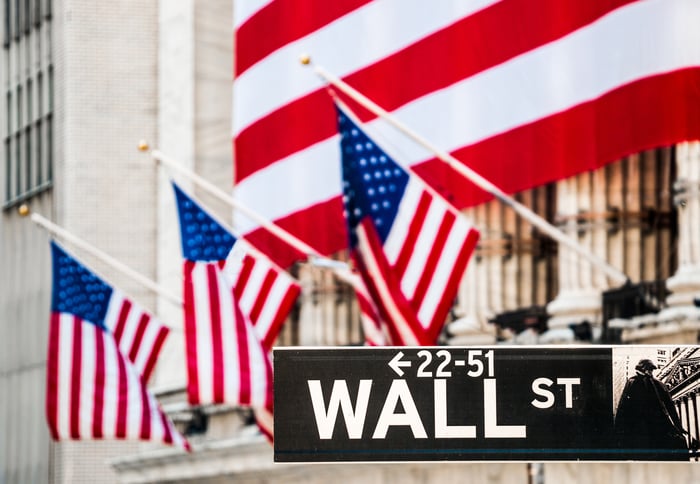The past couple of years have been quite the roller-coaster ride for investors. In 2021, corrections were pretty much nowhere to be found, with access to cheap capital sending growth stocks "to the moon." Comparatively, all three major U.S. stock indexes plunged into a bear market in 2022, with the nation's central bank raising interest rates at the fastest clip in over four decades.
But among the major U.S. stock indexes, it's the Dow Jones Industrial Average (^DJI 0.53%) that's performed the best. Whereas the Nasdaq Composite plummeted 33% in 2022, the Dow Jones bounced back to end lower by just 9%.

Image source: Getty Images.
The reason the Dow has outperformed its peers is because it's packed with 30 generally profitable, mature, multinational businesses. These are typically the types of companies tenured investors seek out when volatility and uncertainty are ruling the roost on Wall Street.
The thing is, bargains still abound within the Dow Jones Industrial Average. What follows are three Dow stocks that stand out as phenomenal values and screaming buys in April.
Walt Disney
The first Dow stock that's a surefire buy in the month of April is the famed "House of Mouse," Walt Disney (DIS 0.63%).
The past three years have possibly been the most difficult in the company's 100-year history. The COVID-19 pandemic led to theme-park shutdowns in many countries, as well as drastically reduced move theater traffic. In other words, the pandemic crippled two of Disney's core revenue channels. But with the worst of the pandemic now in the rearview mirror and China reopening its economy, there's a clear path to sustained (and potentially double-digit) growth out of Walt Disney.
Aside from its theme parks getting back to normal, Disney's biggest growth driver might just be its streaming services. In the three years and one month following the launch of Disney+, the service gained nearly 162 million subscribers. It took rival Netflix more than a decade to surpass 160 million subscribers once it launched its streaming services. A combination of monthly subscription price hikes, the addition of an ad-supported service, and being mindful of costs, should allow Disney+ to deliver its first quarterly profit by the second-half of fiscal 2024.
However, Walt Disney's biggest competitive advantage is its brand. While there are plenty of other theme parks, films, and television programs in the world, the experiences and engagement Disney evokes, as well as the characters and stories it's created, are absolutely irreplaceable. Few companies can connect multiple generations of users through a common theme, but Disney can do exactly that through imagination. It's this insatiable lure of happiness that the company delivers with its theme parks and content that allows it to command exceptional pricing power.
The cherry on the sundae for Walt Disney is that Bob Iger is back in the saddle as the company's CEO. Under Iger's leadership, Disney made a number of growth-driven acquisitions, including Pixar, Marvel Entertainment, and Lucasfilm. Expect Iger to have Disney positioned for years of double-digit earnings growth to come.
At just 18 times Wall Street's consensus earnings for fiscal 2024, Disney looks like a steal for patient investors.
Verizon Communications
A second Dow stock that's begging to be bought in April is telecom giant Verizon Communications (VZ -0.06%).
Telecom stocks have been a forgotten industry for more than a decade. Even though telecom stocks provide hearty dividends, these are mature businesses with modest growth rates that haven't been able to hold a candle to growth stocks that were capitalizing on historically low lending rates. However, with the Fed turning hawkish, value stocks like Verizon are finally (and rightfully) back in focus.
When examined with a wide lens, the best aspect of telecom stocks is the predictability of their cash flow. Most consumers are unwilling to give up their wireless access or smartphones, no matter how poorly the U.S. economy is performing. This is what makes a company like Verizon such a smart play during a bear market.
On a more company-specific level, Verizon should continue to benefit from the 5G revolution. After roughly a decade of 4G LTE download speeds, the introduction of 5G should encourage a steady device replacement cycle for businesses and consumers. The result for Verizon is a sizable uptick in data consumption, which is a boon its wireless division operating margin.
But it's not just Verizon's wireless segment that's getting a healthy boost from 5G. Even though broadband hasn't been a major growth driver for two decades, the 416,000 net broadband additions during the fourth quarter for Verizon represented its best quarter for net additions in over a decade. The sizable investments Verizon made in 5G mid-band spectrum are beginning to pay off handsomely and should lead to an increase in high-margin service bundling.
Despite being well past its growth heyday, Verizon offers an extremely safe floor with its nearly 7% yield and forward-year price-to-earnings ratio of just 8.

Image source: Getty Images.
Johnson & Johnson
The third Dow stock that's a screaming buy in April is healthcare conglomerate Johnson & Johnson (JNJ 6.21%).
J&J, as Johnson & Johnson is more commonly known, has found itself in the spotlight for the wrong reason in 2023. Talcum baby powder lawsuits against the company have been a gray cloud and created some degree of financial liability uncertainty. But in the grand scheme of things, this litigation doesn't impact the company's growth trajectory or strategy.
As I described earlier this week, healthcare stocks like J&J are typically shielded from economic weakness. Since we have no control over what ailment(s) we develop, demand for brand-name drugs, medical devices, and healthcare services remains relatively consistent in any economic environment. While investor sentiment can shift during a bear or bull market, Johnson & Johnson's operating performance tends to be consistent throughout.
For more than 10 years, Johnson & Johnson has been shifting more of its annual revenue to pharmaceuticals. The advantage of this strategy is that it allows J&J to take advantage of the faster sales growth rates and juicier margins associated with brand-name drugs, relative to health products and medical devices.
The other side to this coin is that brand-name drugs have a finite period of sales exclusivity. Thankfully, J&J generated over $21 billion in operating cash flow last year and has plenty of capital to invest in internal research, collaborative partnerships, and occasional acquisitions, to replenish its drug-development pipeline in order to avoid the perils of patent cliffs.
Perhaps the best thing investors get with J&J is continuity. It's had just eight CEOs since being founded in 1886 and is one of only two publicly traded companies to bear the highest credit rating possible (AAA) from Standard & Poor's, a division of S&P Global. In simpler terms, there may not be a more financially sound publicly traded company than J&J.
At roughly 14 times Wall Street's consensus earnings for 2024, Johnson & Johnson is the cheapest it's been (on the basis of forward earnings) in at least a decade.





